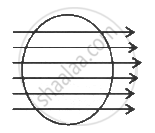Advertisements
Advertisements
प्रश्न
"The outward electric flux due to charge +Q is independent of the shape and size of the surface which encloses is." Give two reasons to justify this statement.
उत्तर
The outward electric flux due to the charge enclosed inside a surface is the number of electric field lines coming out of the surface.
The outward electric flux due to charge +Q is independent of the shape and size of the surface, which encloses it because of the following reasons:
(i) Number of electric field lines coming out from a closed surface enclosing the charge depends on the charge enclosed by the surface, which remains constant with shape and size of the conductor.
(ii) Number of electric field lines coming out from a closed surface enclosing the charge is independent of the position of the charge inside the closed surface.
APPEARS IN
संबंधित प्रश्न
How does the electric flux due to a point charge enclosed by a spherical Gaussian surface get affected when its radius is increased?
Given a uniform electric field `vecE=5xx10^3hati`N/C, find the flux of this field through a square of 10 cm on a side whose plane is parallel to the y-z plane. What would be the flux through the same square if the plane makes a 30° angle with the x-axis ?
What is the net flux of the uniform electric field of previous question through a cube of side 20 cm oriented so that its faces are parallel to the coordinate planes?
Careful measurement of the electric field at the surface of a black box indicates that the net outward flux through the surface of the box is 8.0 × 103 N m2/C.
- What is the net charge inside the box?
- If the net outward flux through the surface of the box were zero, could you conclude that there were no charges inside the box? Why or Why not?
Two charges of magnitudes −3Q and + 2Q are located at points (a, 0) and (4a, 0) respectively. What is the electric flux due to these charges through a sphere of radius ‘5a’ with its centre at the origin?
In a region of space having a uniform electric field E, a hemispherical bowl of radius r is placed. The electric flux Φ through the bowl is:
A charge Qµc is placed at the centre of a cube the flux coming from any surface will be.
An electric charge q is placed at the center of a cube of side ℓ. The electric flux on one of its faces will be ______.
The S.I. unit of electric flux is ______
A circular disc of radius 'r' is placed along the plane of paper. A uniform electric field `vec"E"` is also present in the plane of paper. What amount of electric flux is associated with it?

